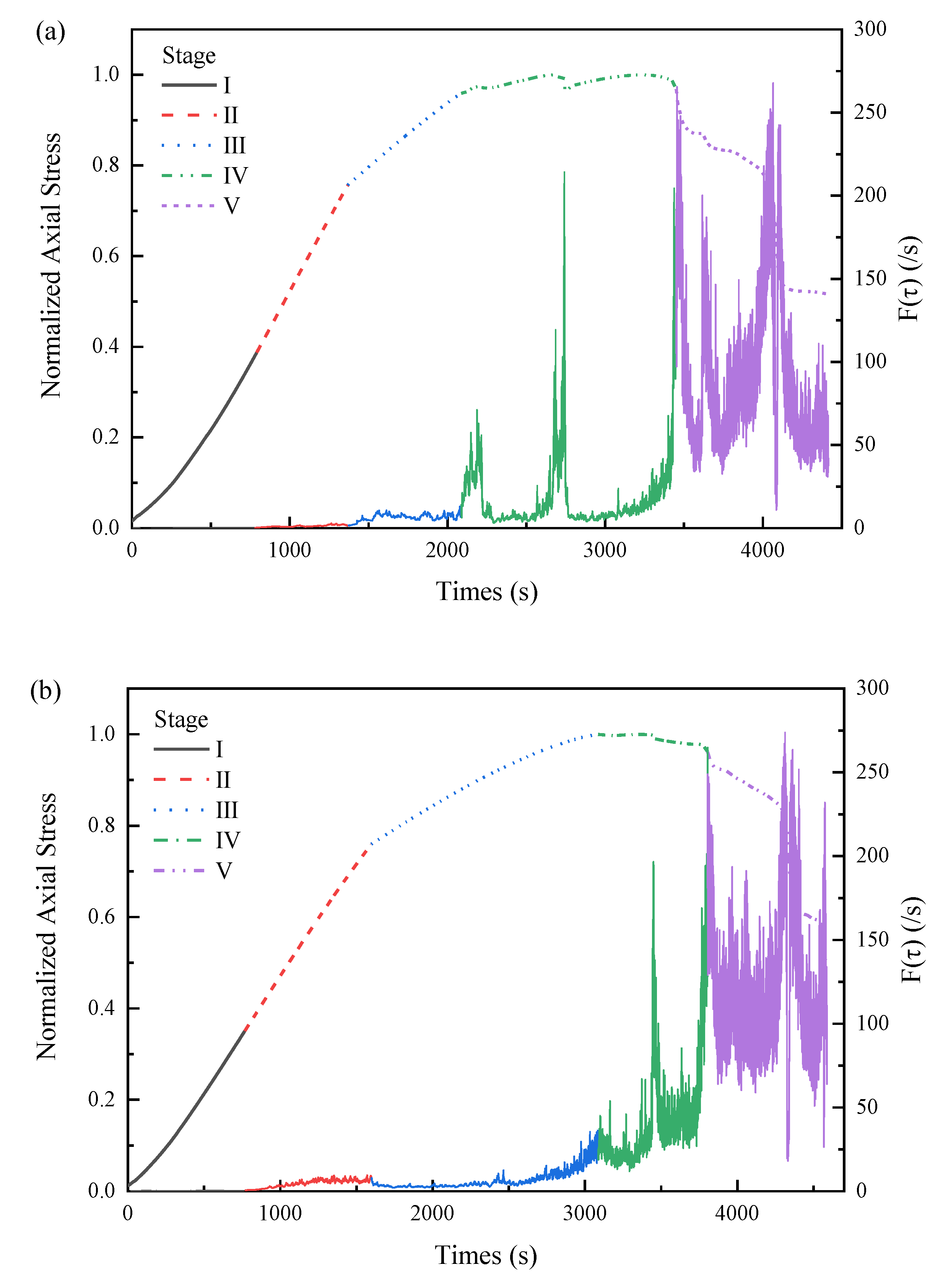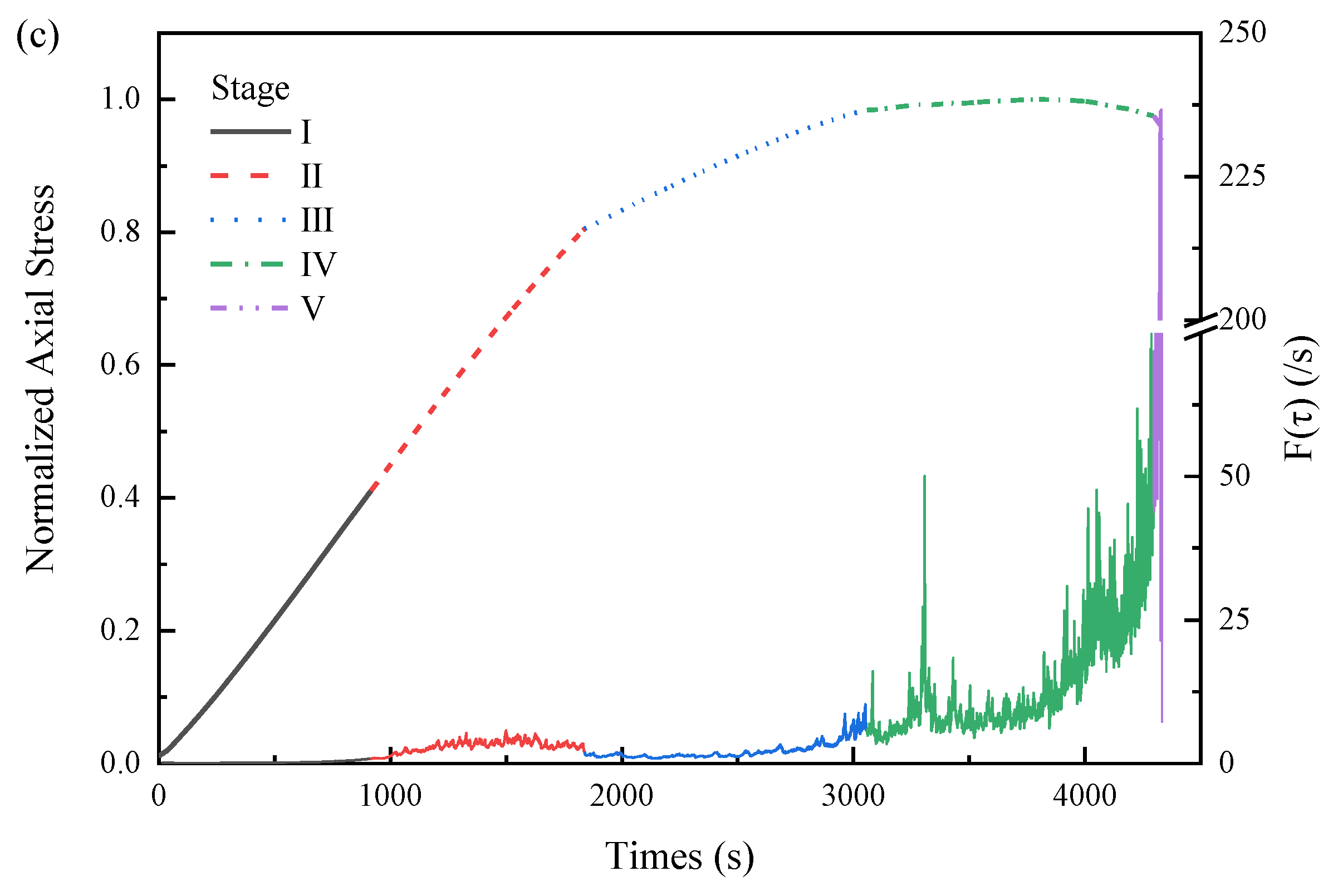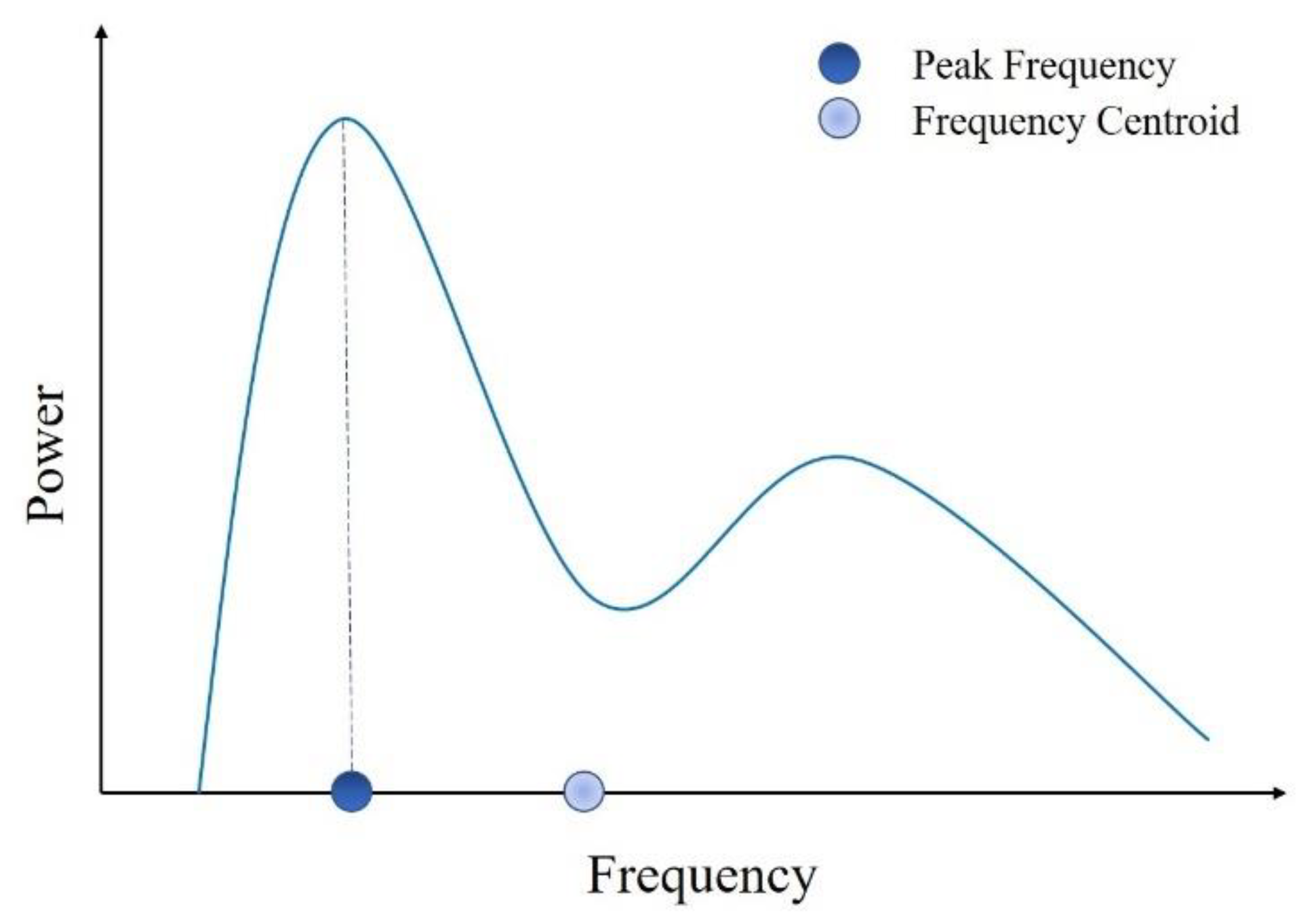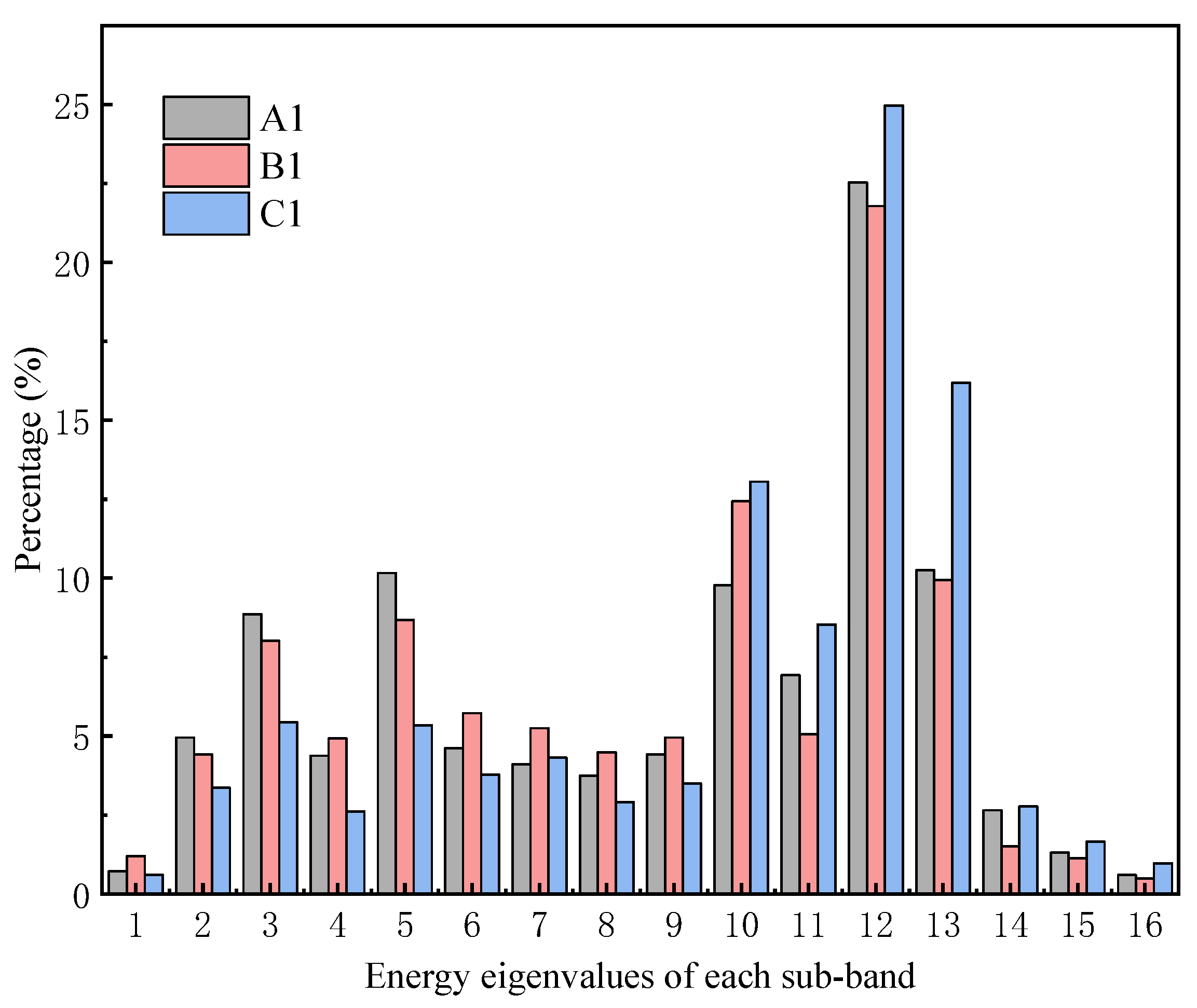Time–Frequency Domain Characteristics of Acoustic Emission Signals and Critical Fracture Precursor Signals in the Deep Granite Deformation Process
Abstract
:Featured Application
Abstract
1. Introduction
2. Test Process and Design
3. Experimental Phenomena and Mechanism Analysis
4. Analysis of Micro-Scale Failure Evolution of Deep Granite Based on IET Function
5. Research on the Frequency-Domain Characteristics of AE Signals
5.1. Discussion on AE Signal Distribution and Peak Stress Precursor
5.1.1. Frequency-Domain Distribution of AE Signals and the Definition of Prediction Signals
5.1.2. Time–Frequency Domain of the P-Signals
5.2. Wavelet Packet Energy Analysis of AE Signals
5.2.1. Wavelet Packet Frequency Band Decomposition of the P-Signals
5.2.2. Energy Distribution of Each Sub-Band
5.2.3. Energy Distribution of the P-Signals
6. Discussion
7. Conclusions
Author Contributions
Funding
Conflicts of Interest
References
- Feng, X.-T.; Liu, J.; Chen, B.; Xiao, Y.; Feng, G.-L.; Zhang, F. Monitoring, Warning, and Control of Rockburst in Deep Metal Mines. Engineering 2017, 3, 538–545. [Google Scholar] [CrossRef]
- Cai, M.; Brown, E.T. Challenges in the Mining and Utilization of Deep Mineral Resources. Engineering 2017, 3, 432–433. [Google Scholar] [CrossRef]
- Li, X.; Gong, F.; Tao, M.; Dong, L.; Du, K.; Ma, C.; Zhou, Z.; Yin, T. Failure mechanism and coupled static-dynamic loading theory in deep hard rock mining: A review. J. Rock Mech. Geotech. Eng. 2017, 9, 767–782. [Google Scholar] [CrossRef]
- Gong, Q.M.; Yin, L.J.; Wu, S.Y.; Zhao, J.; Ting, Y. Rock burst and slabbing failure and its influence on TBM excavation at headrace tunnels in Jinping II hydropower station. Eng. Geol. 2012, 124, 98–108. [Google Scholar] [CrossRef]
- Martin, C.D.; Christiansson, R. Estimating the potential for spalling around a deep nuclear waste repository in crystalline rock. Int. J. Rock Mech. Min. Sci. 2009, 46, 219–228. [Google Scholar] [CrossRef]
- Armaghani, D.J.; Mamou, A.; Maraveas, C.; Roussis, P.C.; Siorikis, V.G.; Skentou, A.D.; Asteris, P.G. Predicting the unconfined compressive strength of granite using only two non-destructive test indexes. Geomech. Eng. 2021, 25, 317–330. [Google Scholar]
- Du, K.; Liu, M.; Yang, C.; Tao, M.; Wang, S. Mechanical and Acoustic Emission (AE) Characteristics of Rocks under Biaxial Confinements. Appl. Sci. 2021, 11, 769. [Google Scholar] [CrossRef]
- Li, H.; Dong, Z.; Yang, Y.; Liu, B.; Chen, M.; Jing, W. Experimental Study of Damage Development in Salt Rock under Uniaxial Stress Using Ultrasonic Velocity and Acoustic Emissions. Appl. Sci. 2018, 8, 553. [Google Scholar] [CrossRef] [Green Version]
- Liu, X.; Zhang, H.; Wang, X.; Zhang, C.; Xie, H.; Yang, S.; Lu, W. Acoustic Emission Characteristics of Graded Loading Intact and Holey Rock Samples during the Damage and Failure Process. Appl. Sci. 2019, 9, 1595. [Google Scholar] [CrossRef] [Green Version]
- Cai, M.; Morioka, H.; Kaiser, P.; Tasaka, Y.; Kurose, H.; Minami, M.; Maejima, T. Back-analysis of rock mass strength parameters using AE monitoring data. Int. J. Rock Mech. Min. Sci. 2006, 44, 538–549. [Google Scholar] [CrossRef]
- Du, K.; Li, X.; Tao, M.; Wang, S. Experimental study on acoustic emission (AE) characteristics and crack classification during rock fracture in several basic lab tests. Int. J. Rock Mech. Min. Sci. 2020, 133, 104411. [Google Scholar] [CrossRef]
- Peng, S.; Sbartaï, Z.M.; Parent, T. Mechanical damage evaluation of masonry under tensile loading by acoustic emission technique. Constr. Build. Mater. 2020, 258, 120336. [Google Scholar] [CrossRef]
- Lei, X.; Satoh, T. Indicators of critical point behavior prior to rock failure inferred from pre-failure damage. Tectonophysics 2007, 431, 97–111. [Google Scholar] [CrossRef]
- Zhang, A.; Zhang, R.; Gao, M.; Zhang, Z.; Jia, Z.; Zhang, Z.; Zha, E. Failure Behavior and Damage Characteristics of Coal at Different Depths under Triaxial Unloading Based on Acoustic Emission. Energies 2020, 13, 4451. [Google Scholar] [CrossRef]
- Zhang, J. Investigation of Relation between Fracture Scale and Acoustic Emission Time-Frequency Parameters in Rocks. Shock. Vib. 2018, 2018, 1–14. [Google Scholar] [CrossRef] [Green Version]
- Liu, J.; Wu, N.; Si, G.; Zhao, M. Experimental study on mechanical properties and failure behaviour of the pre-cracked coal-rock combination. Bull. Int. Assoc. Eng. Geol. 2020, 80, 2307–2321. [Google Scholar] [CrossRef]
- Tuncay, E.; Obara, Y. Comparison of stresses obtained from Acoustic Emission and Compact Conical-Ended Borehole Overcoring techniques and an evaluation of the Kaiser Effect level. Bull. Int. Assoc. Eng. Geol. 2011, 71, 367–377. [Google Scholar] [CrossRef]
- Carpinteri, A.; Lacidogna, G.; Niccolini, G.; Puzzi, S. Critical defect size distributions in concrete structures detected by the acoustic emission technique. Meccanica 2007, 43, 349–363. [Google Scholar] [CrossRef]
- Carpinteri, A.; Lacidogna, G.; Puzzi, S. From criticality to final collapse: Evolution of the “b-value” from 1.5 to 1.0. Chaos Soliton Fract. 2009, 41, 843–853. [Google Scholar] [CrossRef]
- Sagar, R.V.; Rao, M. An experimental study on loading rate effect on acoustic emission based b-values related to reinforced concrete fracture. Constr. Build. Mater. 2014, 70, 460–472. [Google Scholar] [CrossRef]
- Dong, L.; Zhang, Y.; Ma, J. Micro-Crack Mechanism in the Fracture Evolution of Saturated Granite and Enlightenment to the Precursors of Instability. Sensors 2020, 20, 4595. [Google Scholar] [CrossRef]
- Ohtsu, M.; Tomoda, Y. Corrosion Process in Reinforced Concrete Identified by Acoustic Emission. Mater. Trans. 2007, 48, 1184–1189. [Google Scholar] [CrossRef] [Green Version]
- Rodríguez, P.; Celestino, T.B. Application of acoustic emission monitoring and signal analysis to the qualitative and quantitative characterization of the fracturing process in rocks. Eng. Fract. Mech. 2019, 210, 54–69. [Google Scholar] [CrossRef]
- Xu, X.; Dou, L.; Lu, C.; Zhang, Y. Frequency spectrum analysis on micro-seismic signal of rock bursts induced by dynamic disturbance. Int. J. Min. Sci. Technonol. 2010, 20, 682–685. [Google Scholar] [CrossRef]
- Aggelis, D.; Mpalaskas, A.; Matikas, T. Acoustic signature of different fracture modes in marble and cementitious materials under flexural load. Mech. Res. Commun. 2013, 47, 39–43. [Google Scholar] [CrossRef]
- He, M.; Miao, J.; Feng, J. Rock burst process of limestone and its acoustic emission characteristics under true-triaxial unloading conditions. Int. J. Rock Mech. Min. Sci. 2010, 47, 286–298. [Google Scholar] [CrossRef]
- Li, L.R.; Deng, J.H.; Zheng, L.; Liu, J.F. Dominant Frequency Characteristics of Acoustic Emissions in White Marble during Direct Tensile Tests. Rock Mech. Rock Eng. 2017, 50, 1337–1346. [Google Scholar] [CrossRef]
- Zhang, Y.; Wu, W.; Yao, X.; Liang, P.; Sun, L.; Liu, X. Study on Spectrum Characteristics and Clustering of Acoustic Emission Signals from Rock Fracture. Circuits Syst. Signal Process. 2019, 39, 1133–1145. [Google Scholar] [CrossRef]
- Wang, Y.; Han, J.; Li, C. Acoustic emission and CT investigation on fracture evolution of granite containing two flaws subjected to freeze–thaw and cyclic uniaxial increasing-amplitude loading conditions. Constr. Build. Mater. 2020, 260, 119769. [Google Scholar] [CrossRef]
- Ohnaka, M.; Mogi, K. Frequency characteristics of acoustic emission in rocks under uniaxial compression and its relation to the fracturing process to failure. J. Geophys Res. 1982, 87, 3873–3884. [Google Scholar] [CrossRef]
- Moradian, Z.; Einstein, H.H.; Ballivy, G. Detection of Cracking Levels in Brittle Rocks by Parametric Analysis of the Acoustic Emission Signals. Rock Mech. Rock Eng. 2015, 49, 785–800. [Google Scholar] [CrossRef]
- Xue, L.; Qin, S.; Sun, Q.; Wang, Y.; Qian, H. A quantitative criterion to describe the deformation process of rock sample subjected to uniaxial compression: From criticality to final failure. Phys. A Stat. Mech. Its Appl. 2014, 410, 470–482. [Google Scholar] [CrossRef]
- Zhang, J.Z.; Zhou, X.P.; Zhou, L.S.; Berto, F. Progressive failure of brittle rocks with non-isometric flaws: Insights from acousto-optic-mechanical (AOM) data. Fatigue Fract. Eng. Mater.Structures 2019, 42, 1787–1802. [Google Scholar] [CrossRef]
- Zhou, X.-P.; Zhang, J.-Z.; Qian, Q.-H.; Niu, Y. Experimental investigation of progressive cracking processes in granite under uniaxial loading using digital imaging and AE techniques. J. Struct. Geol. 2019, 126, 129–145. [Google Scholar] [CrossRef]
- Lennartz-Sassinek, S.; Main, I.G.; Zaiser, M.; Graham, C.C. Acceleration and localization of subcritical crack growth in a natural composite material. Phys. Rev. E 2014, 90, 052401. [Google Scholar] [CrossRef] [PubMed] [Green Version]
- Triantis, D.; Kourkoulis, S.K. An Alternative Approach for Representing the Data Provided by the Acoustic Emission Technique. Rock Mech. Rock Eng. 2018, 51, 2433–2438. [Google Scholar] [CrossRef]
- Tang, S.; Tong, M.; Hu, J.; He, X. Characteristics of acoustic emission signals in damp cracking coal rocks. Int. J. Min. Sci Technol. 2010, 20, 143–147. [Google Scholar] [CrossRef]
- Ebrahimian, Z.; Ahmadi, M.; Sadri, S.; Li, B.; Moradian, O. Wavelet analysis of acoustic emissions associated with cracking in rocks. Eng. Fract. Mech. 2019, 217, 106516. [Google Scholar] [CrossRef]
- Lee, I.-M.; Han, S.-I.; Kim, H.-J.; Yu, J.-D.; Min, B.-K.; Lee, J.-S. Evaluation of rock bolt integrity using Fourier and wavelet transforms. Tunn. Undergr. Space Technol. 2012, 28, 304–314. [Google Scholar] [CrossRef]
- Liu, X.; Liang, Z.; Zhang, Y.; Wu, X.; Liao, Z. Acoustic Emission Signal Recognition of Different Rocks Using Wavelet Transform and Artificial Neural Network. Shock. Vib. 2015, 2015, 1–14. [Google Scholar] [CrossRef] [Green Version]
- Liu, X.; Wu, L.; Zhang, Y.; Liang, Z.; Yao, X.; Liang, P. Frequency properties of acoustic emissions from the dry and saturated rock. Environ. Earth Sci. 2019, 78, 67. [Google Scholar] [CrossRef]
- Liu, X.-L.; Liu, Z.; Li, X.-B.; Rao, M.; Dong, L.-J. Wavelet threshold de-noising of rock acoustic emission signals subjected to dynamic loads. J. Geophys. Eng. 2018, 15, 1160–1170. [Google Scholar] [CrossRef] [Green Version]
- Wang, Y.; Chen, S.J.; Liu, S.J.; Hu, H.X. Best wavelet basis for wavelet transforms in acoustic emission signals of concrete damage process. Russ. J. Nondestruct. Test. 2016, 52, 125–133. [Google Scholar] [CrossRef]
- Wang, Z.; Ning, J.; Ren, H. Frequency characteristics of the released stress wave by propagating cracks in brittle materials. Theor. Appl. Fract. Mech. 2018, 96, 72–82. [Google Scholar] [CrossRef]












| Specimen | Height/mm | Diameter/mm | Weight/g | Density/g/cm3 | Confining Pressures/MPa |
|---|---|---|---|---|---|
| A1 | 100.81 | 50.04 | 518 | 2.613 | 10 |
| A2 | 100.53 | 50.05 | 509 | 2.575 | |
| A3 | 100.28 | 50.21 | 514 | 2.590 | |
| A4 | 100.96 | 50.14 | 523 | 2.625 | |
| B1 | 100.30 | 50.03 | 516 | 2.617 | 20 |
| B2 | 100.21 | 50.31 | 512 | 2.572 | |
| B3 | 100.46 | 50.07 | 521 | 2.635 | |
| B4 | 100.75 | 50.02 | 516 | 2.608 | |
| C1 | 100.08 | 50.19 | 525 | 2.653 | 30 |
| C2 | 100.65 | 50.00 | 513 | 2.597 | |
| C3 | 100.12 | 50.22 | 517 | 2.608 | |
| C4 | 100.36 | 50.06 | 515 | 2.609 |
| Sub-Band Label | Frequency Band Range/kHz |
|---|---|
| 1 | 0~31.25 |
| 2 | 31.25~62.5 |
| 3 | 62.5~93.75 |
| … | … |
| 16 | 478.75~500 |
Publisher’s Note: MDPI stays neutral with regard to jurisdictional claims in published maps and institutional affiliations. |
© 2021 by the authors. Licensee MDPI, Basel, Switzerland. This article is an open access article distributed under the terms and conditions of the Creative Commons Attribution (CC BY) license (https://creativecommons.org/licenses/by/4.0/).
Share and Cite
Zhang, L.; Ji, H.; Liu, L.; Zhao, J. Time–Frequency Domain Characteristics of Acoustic Emission Signals and Critical Fracture Precursor Signals in the Deep Granite Deformation Process. Appl. Sci. 2021, 11, 8236. https://doi.org/10.3390/app11178236
Zhang L, Ji H, Liu L, Zhao J. Time–Frequency Domain Characteristics of Acoustic Emission Signals and Critical Fracture Precursor Signals in the Deep Granite Deformation Process. Applied Sciences. 2021; 11(17):8236. https://doi.org/10.3390/app11178236
Chicago/Turabian StyleZhang, Le, Hongguang Ji, Liyuan Liu, and Jiwei Zhao. 2021. "Time–Frequency Domain Characteristics of Acoustic Emission Signals and Critical Fracture Precursor Signals in the Deep Granite Deformation Process" Applied Sciences 11, no. 17: 8236. https://doi.org/10.3390/app11178236






